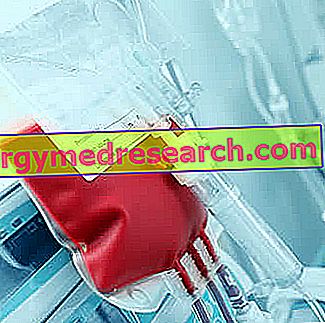Generality
Transfusions consist of transferring a certain amount of blood from one subject (donor) to another (recipient), by intravenous route. This procedure is adopted in response to specific clinical needs.

Transfusions may include the use of whole blood, blood components (concentrates of red blood cells, platelets, plasma, etc.) and / or blood products.
What are
Transfusions consist of the infusion of blood (whole or some of its components) from a donor to a recipient.
Blood transfusions can be:
- Homologues, if donor and recipient are two different people. In this case, it is essential to establish compatibility, defining the blood group of those who donate and those who receive, to avoid serious consequences;
- Autologous, if donor and recipient are the same person. In the latter case, obviously it is necessary to proceed with the collection of blood bags before the time of need (for example, in preparation for a scheduled surgery).
From what blood is composed
Blood is a fluid consisting of:
- Liquid and yellowish part: plasma;
- Corpuscular part: includes different types of cells, in particular red blood cells, white blood cells and platelets.
With transfusions it is possible to administer whole blood, individual blood components and / or blood products:
- Blood components: they are derived from the fractionation of the blood with simple physical means or with apheresis (technique that allows to selectively take only one cellular component). Blood components include: concentrated red blood cells, platelet concentrates, granulocyte concentrates, fresh concentrated plasma, cryoprecipitate, etc.
- Blood derivatives: they are obtained by industrial plasma fractionation; these can be used as plasma-derived drugs (ie medicinal products extracted from the blood) used for the treatment of diseases such as haemophilia type A and type B, primary immunodeficiencies, haemorrhagic diseases and others.
Blood products may include: albumin (used for patients suffering from severe protein deficiencies, burns or in a state of shock), immunoglobulins (for the detection of specific antibodies or when an infectious disease is in progress), concentrates of coagulation factors (for all sick people who have deficiencies or for hemophiliacs) etc.
In general, today there is a tendency to limit whole blood transfusions to the cases in which it is indispensable, while it is preferred to use blood components individually.
What is the blood for?
The main function of blood is to transport and distribute nutrients and respiratory gases (starting with oxygen) that pass through our body. At the same time, the blood circulation frees the tissues from waste products, bringing them to the organs that have the function of eliminating them.
Hormones, vitamins, enzymes and other substances important for maintaining the general balance of the organism also travel in the blood.
Through the circulation, an optimal defense of the organism is carried out from the attack of pathogenic microorganisms, thanks to the activity of the white blood cells that intervene promptly to avoid or try to limit an infection.
Where does transfusion blood come from?
Blood transfusions are procedures to which maximum attention is dedicated, in order to always guarantee quality and safety conditions.
Blood is collected by voluntary donors at a national blood transfusion center; the bags are then tested with advanced methods to verify their conformity.
There is also the possibility of pre-depositing one's own blood in the weeks preceding a planned and not particularly demanding operation: in this case, one speaks of autotransfusion .
The blood is collected in a container in which a liquid is present that prevents coagulation, to be preserved and made available in case of need.
Compatibility, blood type and Rh factor
In the case of homologous transfusion, the compatibility between donor and recipient is fundamental, to avoid serious haemolysis reactions; to establish it, it is necessary to define the blood group of both.
On the surface of the red blood cells there are molecules called antigens: these determine the blood group to which one belongs, therefore the compatibility of the transfused blood. Antigens are defined by the letters A and B or by the number 0.
The possible combinations are:
- Group A : antigen A is present on red blood cells and anti-B antigen IgM plasma antibodies. These patients may receive group A and 0 red blood cells.
- Group B : these people have antigen B on red blood cells and IgM anti-A antigen in plasma. As a result, they can receive group B and 0 red blood cells.
- Group AB : both the antigen A and the antigen B are present on the red blood cells and in the plasma they have no antibody. Group AB subjects are universal recipients, as they can be transfused with group A, B, AB and 0 red blood cells.
- Group 0 : subjects with blood group 0 have no antigen on red blood cells and in plasma have IgM antibodies to antigen A and anti antigen B. Subjects with group 0 can only receive group 0 blood, while they can donate to all groups (universal donors).
To these is added the so-called Rh factor (Rhesus D) which may or may not be present on the surface of red blood cells ( Rh positive or Rh negative ):
- Subjects with Rh-negative factor can receive blood only from subjects with Rh-negative factor, because Rh-positive blood transfusion can induce the production of anti-Rh antibodies;
- Subjects with Rh positive can receive positive and negative Rh blood.
When and why are they performed?
Blood transfusions can be used for prophylactic purposes (eg before cytotoxic therapy or surgery) or therapeutic (eg bleeding in progress).
Transfusion therapy is necessary and represents a life-saving procedure in the event of:
- Accident with great blood loss;
- Major surgical interventions, random or iatrogenic bleeding in minor ones;
- Acute phase of disseminated intravascular coagulation;
- Organic bleeding (thalassemia, leukemia, lymphoma, neoplasias, hemophilia, bleeding from the digestive tract, etc.);
- Poisonings;
- Burns;
- Obstetric complications (eg placenta previa);
- Organ transplants.
Your doctor may prescribe the use of blood transfusions on numerous other occasions, such as:
- In the management of chronic diseases, such as, for example, thalassemia;
- Correct coagulation and / or bleeding disorders;
- Overcoming a deficiency in the immune system;
- Intervene in states of severe anemia, to maintain a correct transport of respiratory gases (oxygen and carbon dioxide);
- Restore / maintain volume, that is the mass of circulating blood, to avoid a state of shock;
- As an antagonist of oral anticoagulants in the presence of hemorrhagic manifestations;
- To overcome critical states due to blood diseases (such as leukemia) or effects due to chemotherapy that can damage bone marrow cells and require support for its repopulation.
Generally speaking, blood transfusions should be performed only when there is a precise indication and cannot be substituted with pharmacological treatments. Furthermore, transfusion therapy must be conducted as much as possible with blood components and specific blood products for the deficits to be corrected.
How to do it
During the transfusion, the donor's blood, previously collected in a bag, is infused into the recipient's vein. The procedure can last from one to four hours, depending on how much blood has to be transfused.
The stages of the transfusion process include, in summary, the following moments:
- Blood sample collection for pre-transfusion tests (group determination, search for irregular antibodies and compatibility test);
- Emocomponents request, acceptance, registration, testing and delivery at the transfusion facility;
- Transfusion in the ward, operating room, intensive care or home.
The pre-filing withdrawal for autologous purposes must be carried out under the control of a transfusion facility. In general, no more than 4 units of blood are taken and, usually, unused bags are eliminated. After the last sample, an interval of at least 3 days is recommended (on average 7 to 15 days) before proceeding to surgery.
Pretrasfusion investigations
To prevent the greatest number of complications, before carrying out the blood transfusion, specific typing and antibody screening procedures are followed which include:
- Determination of blood group (A, B, 0, AB) and Rh type (positive or negative) of donor and recipient;
- Test to detect any presence of infectious diseases;
- Search for irregular antibodies;
- Greater compatibility tests (cross-match).
Contraindications and risks
In most cases, blood transfusions do not lead to adverse effects or complications. However, being a biological product of human derivation, blood will never be completely risk free.
During transfusion treatment, in particular, they can occur more commonly (in about 1-2% of cases):
- Allergic reactions : they can develop even if the donor's blood is compatible with that of the recipient. Symptoms associated with this phenomenon include: difficulty breathing, chest pain, reduced blood pressure and nausea. When such disorders occur, health professionals should be alerted immediately. At the first signs of an allergic reaction, in fact, the transfusion must be suspended and, depending on the severity of the symptoms and the condition, the doctor will evaluate the most appropriate treatment.
- Viral infections (hepatitis B or C, HIV) : they are very rare, as the current legislation regulates the choice of donors in a very precise and accurate way, assessed on the basis of clinical history and specific preliminary tests. In addition, some laboratory tests are carried out on each unit of blood collected to exclude the presence of infections (AIDS, hepatitis B, hepatitis C, syphilis etc.). This greatly reduces the risks for recipients.
- Fever : it is the most frequent consequence of transfusions; it must be treated with a common antipyretic as in common febrile manifestations, but it must always be evaluated, since it could be an expression of a reaction of incompatibility.
Other less frequent reactions are:
- Liquid overload;
- Lung damage;
- Hemolytic reactions characterized by the destruction of erythrocytes, due to the mismatch between the blood group of the donor and the recipient.
Pharmacological alternatives
Currently, there is no alternative to transfusions. However, it is possible to try to compensate for the functions of certain blood components with specific drugs. In particular, in the presence of certain renal problems it is possible to take erythropoietin, able to accelerate the production of red blood cells.
Measures to reduce risks
The risks associated with blood transfusions may be limited with appropriate care:
- Homologous blood transfusions must be avoided in all those cases (such as for planned and non-urgent surgical procedures) in which it is possible to implement autotransfusion procedures.
- Before withdrawing and transfusing blood, the healthcare professional must identify the person who is to receive the transfusion, specifically ascertaining his identity.
- The exam request forms and / or blood components, including the labels of the recipient sample collection tubes, must be filled in clearly and completely.
- Patients must be identified with certainty both when the blood samples are taken for pre-transfusion investigations and when they are administered.
- Before transfusion, blood components must be stored at a suitable temperature and must be evaluated with an inspection to highlight any anomalies.
- At the time of the transfusion it is necessary to check the correspondence of the data shown in the folder, on the forms accompanying the blood component and on the labels affixed to it relating to: patient age and compatibility of the blood group.
- The progress of the transfusion must be constantly monitored; before and during the procedure the vital parameters of the recipient must be detected and recorded.
- The patient must be instructed on the symptoms attributable to a possible transfusion reaction, so he is invited to report them promptly if he should warn them.



